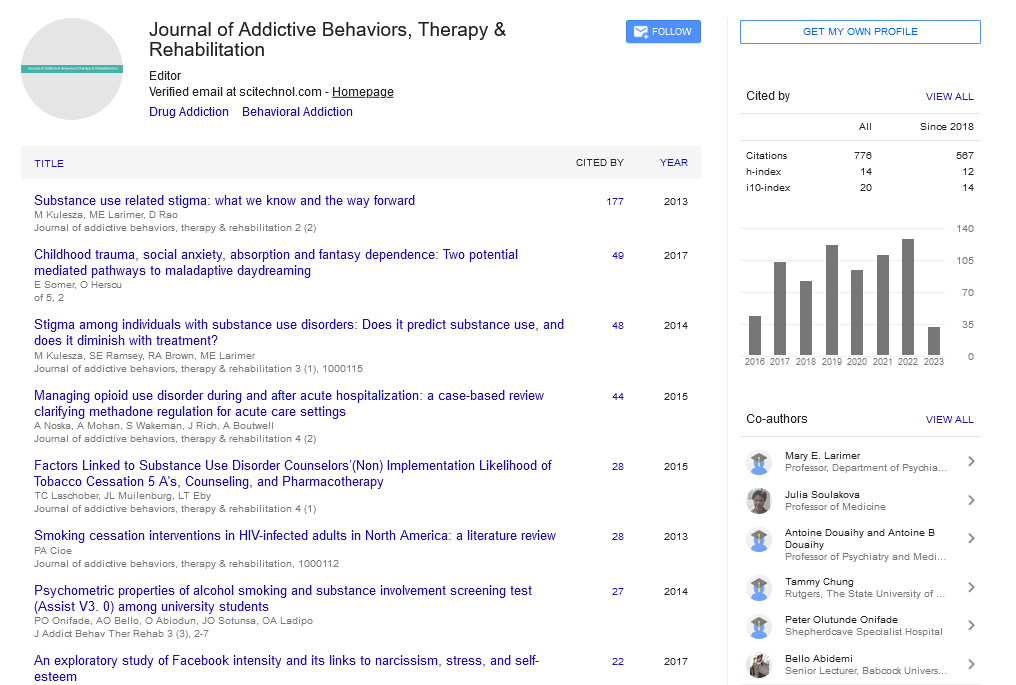Opinion Article, J Addict Behav Ther Rehabil Vol: 13 Issue: 1
Into the Abyss: Understanding Sedative Dependence
Alexander Lovato*
1Department of Medicine, Flinders University, Adelaide, Australia
*Corresponding Author: Alexander Lovato,
Department of Medicine, Flinders
University, Adelaide, Australia
E-mail: alexander.lovato@flinders.edu.au
Received date: 26 January, 2024, Manuscript No. JABTR-24-135778;
Editor assigned date: 28 January, 2024, PreQC No. JABTR-24-135778 (PQ);
Reviewed date: 13 February, 2024, QC No. JABTR-24-135778;
Revised date: 21 February, 2024, Manuscript No. JABTR-24-135778 (R);
Published date: 29 February 2024, DOI: 10.4172/2324-9005.1000081
Citation: Lovato A (2024) Into the Abyss: Understanding Sedative Dependence. J Addict Behav Ther Rehabil 13:1.
Description
This study begins embarks on a comprehensive of the intricate world of sedative dependency, shedding light on the complexities and challenges individuals face when grappling with addiction to these powerful substances. Sedatives, including benzodiazepines and prescription sleep aids, are commonly prescribed to treat anxiety, insomnia, and other related conditions. However, their potential for misuse and dependency poses significant risks to individuals' physical, psychological, and social well-being. By delving into the depths of sedative dependence, this examination aims to elucidate its origins, manifestations, consequences, and avenues for recovery. Sedatives, with their calming and tranquilizing effects, offer respite from the stresses and anxieties of daily life.
Individuals struggling with insomnia or anxiety disorders, these medications can provide much-needed relief, allowing them to relax and find solace in sleep. However, the allure of tranquility often masks the potential for dependency, as individuals may become increasingly reliant on sedatives to cope with life's challenges. Moreover, the normalization of sedative use in society, coupled with aggressive marketing tactics by pharmaceutical companies, contributes to the perception that these medications are safe and effective solutions for managing stress and sleep disturbances. As a result, many individuals may underestimate the risks associated with long-term use and fail to recognize the signs of dependency until they find themselves ensnared in its grip. Despite their initial promise of tranquility, sedatives cast long shadows of dependency that can envelop individuals in a cycle of addiction and despair.
Prolonged use of these medications can lead to tolerance, where individuals require increasingly higher doses to achieve the desired effects. This tolerance, coupled with the development of physical and psychological dependence, makes it challenging for individuals to discontinue use without experiencing withdrawal symptoms. The withdrawal process, characterized by symptoms such as rebound anxiety, insomnia, agitation, and even seizures, can be overwhelming and debilitating, further reinforcing the cycle of dependency. Moreover, the stigma surrounding addiction and the fear of judgment or ostracism may prevent individuals from seeking help or disclosing their struggles, exacerbating feelings of isolation and shame.
"Into the Abyss" offers a beacon of hope for individuals grappling with sedative dependence, guiding them through the labyrinthine journey of recovery with empathy, understanding, and resilience. By illuminating the pathways to healing and empowerment, this exploration empowers individuals to confront their addiction, reclaim their agency, and forge a path toward a brighter future. Recovery from sedative dependence is a multifaceted process that encompasses physical, psychological, and social dimensions. Detoxification, under the supervision of medical professionals, may be necessary to safely manage withdrawal symptoms and stabilize individuals' physical health. However, detoxification alone is not sufficient to address the underlying issues driving addiction.
Therapeutic interventions, such as Cognitive-Behavioural Therapy (CBT), Dialectical Behavior Therapy (DBT), and mindfulness-based approaches, offer valuable tools for individuals to explore the root causes of their addiction, identify maladaptive thought patterns and behaviours, and develop healthier coping strategies. By cultivating self-awareness, resilience, and emotional regulation skills, individuals can gradually unravel the tangled web of dependency and reclaim control over their lives. Furthermore, social support networks, including family, friends, support groups, and peer mentors, play a crucial role in the recovery process. These networks provide a sense of belonging, understanding, and encouragement, helping individuals navigate the challenges of addiction and celebrate their successes along the journey to sobriety.
The above findings concludes with a message of hope and resilience, reminding individuals that recovery is possible and that they are not alone in their struggles. By shedding light on the complexities of sedative dependence, this exploration seeks to destigmatize addiction, foster empathy and understanding, and promote meaningful change in how society perceives and supports individuals grappling with dependency. Through knowledge, awareness, and support, individuals can emerge from the depths of addiction, empowered to reclaim their lives, rebuild their relationships, and pursue their dreams with renewed vigor and purpose. Ultimately, "Into the Abyss" serves as a testament to the human capacity for resilience, transformation, and redemption, inspiring individuals to embark on the journey to recovery with courage, determination, and hope.
 Spanish
Spanish  Chinese
Chinese  Russian
Russian  German
German  French
French  Japanese
Japanese  Portuguese
Portuguese  Hindi
Hindi 